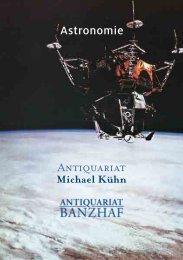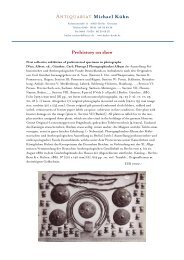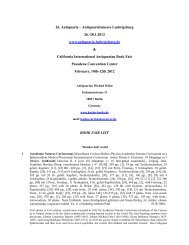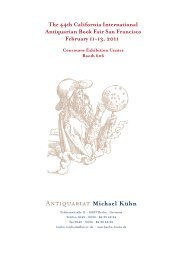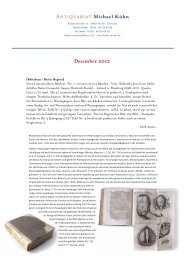List New York Antiquarian Book Fair - Antiquariat - Michael Kühn
List New York Antiquarian Book Fair - Antiquariat - Michael Kühn
List New York Antiquarian Book Fair - Antiquariat - Michael Kühn
Create successful ePaper yourself
Turn your PDF publications into a flip-book with our unique Google optimized e-Paper software.
gate.- Freiburg im Breisgau: Stephan Graf, 1543. [104] leaves with numerous tables &<br />
woodcut diagrams.<br />
[bound with:]<br />
Sacrobosco, Johannes de. [Melanchthon, Ph., Reinhold, Erasmus] Libellus de Sphaera.<br />
Accessit autoris computus ecclesiasticus, et alia quaedam in studiosorum gratiam edita. Cum<br />
praefatione Philippi Melanchthonis.- Wittenberg : Veit Kreuzer, 1545. 129 leaves. The 7<br />
leaves with Melanchthon’s preface have not been bound in this copy: for catholic censorship !<br />
Melanchthon’s name has also been inked out of the title-page, as often. With numerous astronomical<br />
diagrams in the text, of which two with volvelles. At the end are bound two large<br />
fold. tables. $ 4800.-<br />
I.) Rare fifth edition of this elementary introduction into geometry, mainly based on Euclid. Johann Vögelin (end<br />
of 15 th cent. – 1549) from Heilbronn, lectured mathematics in Vienna from 1525. He succeeded Tannstetter as<br />
Prof. at the University of Vienna. “Obwohl Vögelins Werk wissenschaftlich nichts Neues brachte, wurde es im<br />
Universitätsunterricht oft benutzt und mehrfach nachgedruckt.“ – HAB, Maß, Zahl u. Gewicht 62; Graf-Stuhlhofer,<br />
Tannstetter 1996. pp. 56-68; Steck, Euclid. 53<br />
II.) Rare second edition of this mathematical primer, first printed in Strasbourg (1536) and than in Freiburg<br />
(1543,1550). This is an arithmetic book in the traditional style. Rather than being practical like the Arithmeticae<br />
practicae of Gemma Frisius (which was published only four years later), this work follows the tradition of Boethius.<br />
It begins with a discussion of number theory, figurative numbers, etc. but does include a more practical<br />
sec-tion on basic arithmetic at the end. The work closes with a small section on the use of the table abacus.<br />
What both DeMorgan and Smith overlooked is that this book holds an important place in the history of number<br />
theory. Perfect numbers are those whose divisors sum up to the number itself, e.g. 1+2+3=6 and 1+2+4+7+14 =<br />
28. Nichomachus knew that the first four perfect numbers were 6, 28, 4096, and 8128. On the basis that the first<br />
had a single digit, the second was two digits, the third three, and the fourth four digits, he predicted that the fifth<br />
perfect number would have five digits, the sixth would have six, etc. This made sense from the Pythagorean view<br />
of numbers in that it provided symmetry. It eas also suspected that 2p-1 (2p-1) was always a perfect number.<br />
Regius found the factors of 2³-1 = 2047 = 23 x 89, which disproved this last conjecture. … It was, of course, discoveries<br />
like these that led to the decline in the study of the ancient mathematicians [Nicomachus proved<br />
wrong]. Little is known about Ulrich regius (Rieger); he was a school teacher and preacher at Freiburg.– Tomash<br />
Coll. R62 [Straßbourg ed.]; Smith, Rara 182; VD16 ZV13011<br />
III.) Ninth edition, the fifth Wittenberg imprint of Sacroboscos Sphaera, edited by Philip Melanchthon. “Sacrobosco’s<br />
Sphaera, written in paris around 1220, enjoyed a long popularity as the leading introduction to spherical<br />
astronomy. First printed in 1472, it went through at least a score of editions in the 15 th cent. And something over<br />
100 in the 16 th cent. Publishing Sacrobosco entered a new and different phase in Wittenberg in 1531. Prior to that<br />
year all the editions were folio or quarto, often quite expensive. In 1531 the Lutheran University of wittenberg<br />
apparently sponsored a version cheap enough to become a required textbook for the astronomy course. It is fully<br />
illustrated with didactic figures, and comes with a preface in praise of astronomy by Philipp Melanchthon [here<br />
omnitted by the catholic census]. In 1538 a revised revision appeared: for the first time three of the diagrams<br />
incorporated moving parts. This proved to be such a popular feature that virtually every octavo Sacrobosco from<br />
the 1540’s on – regardless where printed – included these same identical volvelles. [O. Gingerich]. At the end is<br />
printed Erasmus Reinhold’s text Themata quae continent methodicam tractationem de horizonte, … Lit.: O. Gingerich.<br />
Sacrobosco as a textbook, in: History of Astronomy XIX (1988), 269-273; Reich. Melanchthon und die<br />
Mathematik; in: Frank/Rhein [eds.] Melanchthon u. d. Naturwiss. pp. 116. Gastgeber in: Biblios 46 (1997), 19-<br />
51; VD16 J726; Houzeau/Lan. 1653.<br />
Heart Beat Registration – Electrocardiogram (ECG) invented<br />
Einthoven, Willem. Galvanometrische registratie van het menschelijk electrocardiogram. in:<br />
Herinnerings-bundel Prof. S. S. Rosenstein.- Leiden: E. Ijdo, 1902. 4°. VIII, 741 pp. Contemporary<br />
publisher cloth with printed cover title, rubbed and soiled, but a fine copy. $ 3000<br />
First edition of his paper announcing the first modern ECG registration, which was obtained with his newly<br />
developed string galvanometer. The key sensing element of the apparatus is a thin silver-coated quartz string that<br />
is placed in a strong magnetic field. Willem Einthoven de-monstrates the improved results obtained with his new<br />
equipment for registering the electrical activity of the heart. He shows the superior performance of the string



